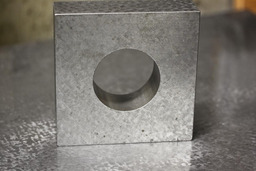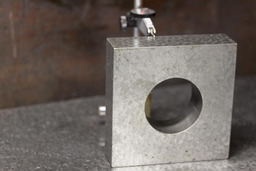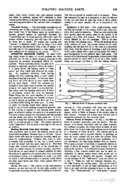The use of a Hand Scraper may be undertaken for two logically distinct purposes.
"Hand Scraping" proper is the process of using a scraper held in the hands to remove small amounts of metal from a precision surface so as to provide an accurate bearing surface to within some tolerance. (The scraper itself may be either manual or powered; the use of a power scraper is still hand scraping because the tool is held in and controlled by the hands.) This kind of hand scraping is the way in which the finest machine slideways have been produced from the early 19th century to the present. The finish it produces may be attractive in its own way, but it is functional process, not a decorative one. This kind of hand scraping is the topic of this present Notebook.
Hand scraping may also be done to produce a decorative finish on a surface. When this is doen, it is often termed Frosting or Flaking (q.v.)
The best photographs available of functional hand scraping are those in Michael Ward's series of articles, "Scraping for the Home Shop," in The Home Shop Machinist .
flickr user NVinacco ( http://www.flickr.com/photos/nvinacco/) has posted four lovely photographs of hand scraped work. All of the items in them (both the block and the surface plate) were scraped using a carbide scraper. (Please note that these are licensed by him under the Creative Commons Attribution-Noncommercial-NoDerivatives 2.0 license, a license which differs from that of the rest of this page. Please respect this.)



1911. Fairfield. Machinery.
Fairfield, H. P. "Hand Scraping." In the "Machine Shop Practices" column of Machinery, 1911.
Note: Machinery seems at that time to have been published in three distinct editions: "Engineering," "Shop," and "Railway." This article appeared in the Engineering Edition, Vol. 17, No. 5 (February, 1911): 474-476. It may also have appeared in the Shop Edition (Vol. 17 [, No 5 (February, 1911) ?]: 314ff) and in the Railway Edition (Vol. 10 [, No. 5 (February, 1911) ?]: 474ff.)
The Engineering Edition (Vol. 17) has been digitized by The Internet Archive from the University of Toronto copy. This is available online at: http://www.archive.org/details/machinery17newy There you can view it online, or download PDF or DjVU versions, or download the original scans. The icon here links to a PDF assembled from the original scans of just the three pages of Fairfield's article.

1917. Machinery's Encyclopedia
A.S. "Scraping Machine Parts." in Machinery's Encyclopedia. Volume V. (NY: The Industrial Press, 1917)
This article covers a broad range within the subject. Part of it covers ordinary functional and decorative scraping (and part of that, in turn, is recycled from Fairfield's 1911 article as noted above). But part of it also deals with the dragging of heavy machine elements against each other to diagnose their bearing surfaces.

1924. Wheeler. Popular Science.
Wheeler, H. L. "How to Scrape Metal Surfaces." Popular Science, Vol. 105, No. 3 (Sept. 1924): 84, 86, 88. Viewable online via Google Books.
While this article is good in its own way, it tries to cover the entire field in a couple of pages (including regular hand scraping, bearing scraping, and frosting). It is of particular interest, though, because (a) it shows an unusual method of sharpening the hand scraper which involve a diagonal cutting surface on the end of the blade (of a scraper with a convex cross-section), and (b) it shows three patterns for frosting: "crescent," "diagonal diamond," and "straight diamond."

1955. Connolly. Machine Tool Reconditioning
Connelly, Edward F. Machine Tool Reconditioning. (St. Paul, MN: Machine Tool Publications, 1955). This book has an almost legendary status. It is perhaps the most thorough book on the subject ever written. Note, however, that while it does discuss the methods of hand scraping briefly, its primary concern is with their application to machine tool reconditioning. Most of it, therefore, is devoted to analyzing and correcting faults in machine tool geometry.
This book is still in print, although it is not inexpensive.

1970. Moore. The Foundations of Mechanical Accuracy.
Moore, Wayne R. The Foundations of Mechanical Accuracy. (Bridgeport, CT: The Moore Special Tool Company, 1970.) This book can still be bought direct from the writer's company (now the Moore Tool Company, http://www.mooretool.com/publications.html)
The Moore jig borers and coordinate measuring machines were the finest ever made; this is how they got that way. Only a small portion of the book concerns the mechanics of hand scraping, but it remains an essential volume for anyone concerned with the accuracy of machines.
(If anyone ever tells you that three plates are used to generate an original set of surface plates because "if two plates are equal to a third they must all be planar" (or the like), this is the volume to which to direct them in order to dispel this oversimplification.)

1981. Wade. The Art of Hand Scraping
Wade, Robert R. The Art of Hand Scraping. (Berkeley, CA: Lawrence Livermore Laboratory, 1981). This booklet focusses primarily on pull scraping, a method not frequently discussed elsewhere.
The original of this paper is in the public domain due to failure to comply with copyright formalities at the time of publication. At the present time there are two copies of it online. One is a single file at http://users.beagle.com.au/lathefan/ The other consists of three files at: http://barneyfest.com/pics/scraping-01.pdf, http://barneyfest.com/pics/scraping-02.pdf, and http://barneyfest.com/pics/scraping-02.pdf. The exact provenance of each is difficult to determine. Both versions are scans of a photocopy (not of an original printed version), so the illustrations in both are of poor quality. There are minor differences between them, but it would appear likely that both are scans of the same photocopy.

2000. Morgan. Basic Scraping, Modern Methods
Morgan, Michael. Basic Scraping, Modern Methods (published by the author). There is a companion video, Basic Hand Scraping. See: http://www.machinerepair.com/
Morgan gives a good introduction to the practical sharpening and handling of the scraper.

2003. Forrest Addy. (Online)
There are any number of discussion threads on the Internet about hand scraping - some more useful, some less. When the name Forrest Addy comes up, though, it is wise to pay attention. In particular, I find a posting that he made to the "homeshopmachinist.net" forums on 2003-12-22 to be particularly useful. It is a part of a thread at http://bbs.homeshopmachinist.net/archive/index.php/t-4673.html

2008- . Nick Mueller. (YouTube)
Nick Müller ( Müllersche Motor-Manufaktur München) has made several videos of hand scraping procedures available via YouTube (along with some, er, spirited commentary on the nature of the modern international machine tool industry). See: http://www.youtube.com/user/MuellerNick/

2011- . Ward. Home Shop Machinist.
As I write this in 2012, Michael Ward has been writing an extended series of articles, "Scraping for the Home Shop," in The Home Shop Machinist. It is an extraordinary series which, in my opinion, has already become the modern standard reference for practical shop work in this field. I very much hope that it is reissued in book form.

2012. "K&J Scraping: Training Video"
K & J Scraping ( http://www.kjscraping.com) have posted a video to YouTube showing scraping procedures. It is interesting in that it shows the use of not one but two spotting compounds (neither fully identified) for improved clarity. See: http://www.youtube.com/watch?v=nOJrhrne80s
The four photographs by flickr user NVinacco are licensed under the Creative Commons Attribution-NonCommercial-NoDerivatives 2.0 license.
The 1911 volume of Machinery from which the Fairfield article is reprinted is in the public domain. The digitization of it at The Internet Archive and the extracts reprinted here remain in the public domain.
The 1917 volume of Machinery's Encyclopedia is in the public domain. The digitization of it by Google and the extracts reprinted here remain in the public domain.
All portions of this document not noted otherwise are Copyright © 2012 by David M. MacMillan and Rollande Krandall.
Circuitous Root is a Registered Trademark of David M. MacMillan and Rollande Krandall.
This work is licensed under the Creative Commons "Attribution - ShareAlike" license. See http://creativecommons.org/licenses/by-sa/3.0/ for its terms.
Presented originally by Circuitous Root®
Select Resolution: 0 [other resolutions temporarily disabled due to lack of disk space]